Central tyre inflation systems – the options and prices
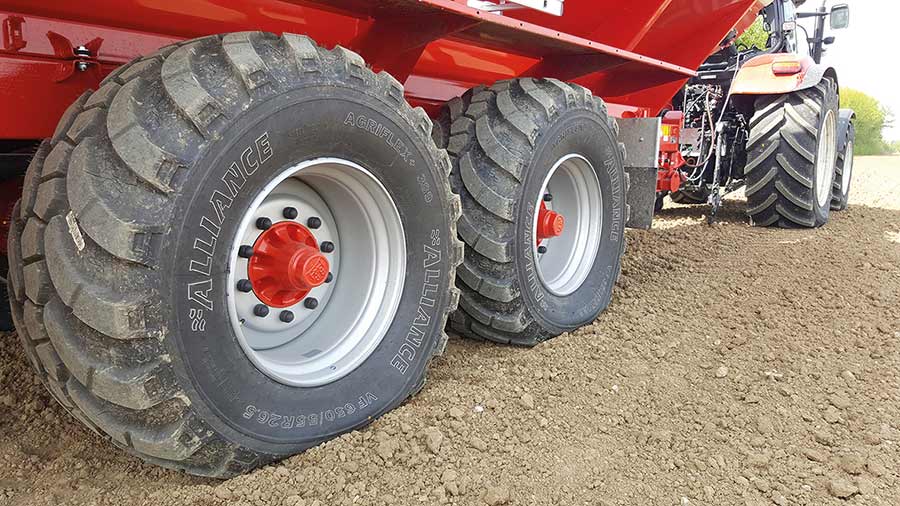 How low can you go? Alliance Agriflex+ 389 VF tyres © Yokohama
How low can you go? Alliance Agriflex+ 389 VF tyres © Yokohama Pump ’em up for the road, let ’em down for the field. That is the essence of using a central tyre inflation system (CTIS) to actively manage inflation pressures and make the most of strong but highly squashable tyres for tractors, self-propelled machines and trailed equipment.
Investing in a set of IF-marked tractor tyres provides scope to get fieldwork inflation pressures down 20% for a given load versus a conventional tyre of the same size.
Stepping up to VF category rubber brings an even bigger advantage; a 40% reduction size-for-size under comparable circumstances.
An opportunity, then, to get field pressures for all but the most extreme situations into low single figures, even as the size, weight and power of tractors continue to rise.
This will help reduce soil compaction, improve traction, minimise wear rates and make trailed equipment easier to pull.
See also: Video: First drive: Fendt’s 415hp 942 Vario
John Deere
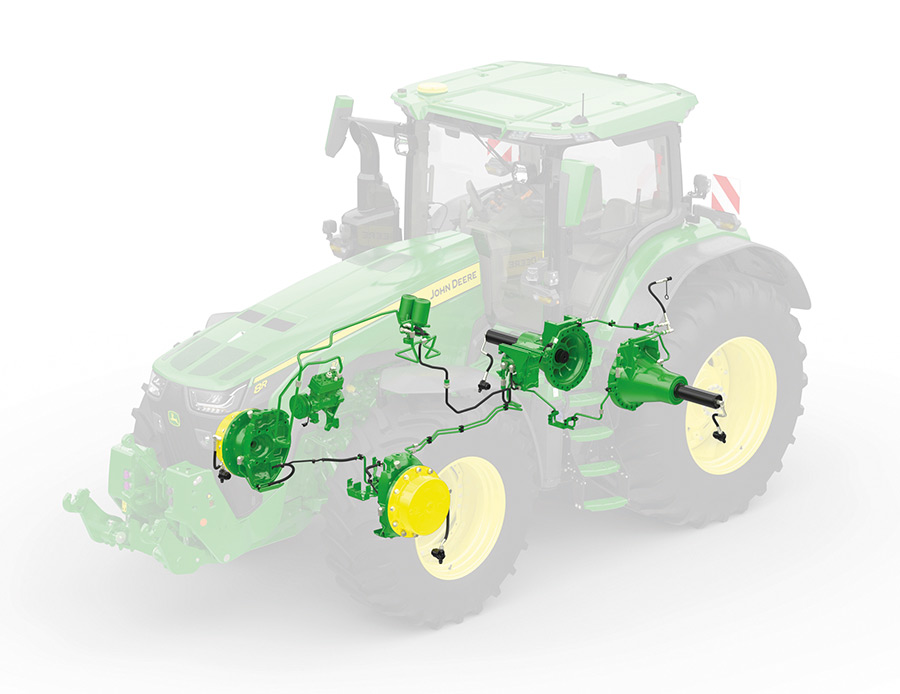
John Deere’s integrated system on an 8R © John Deere
As their advantages are more widely recognised, VF – for Very High Flexion – tyres are increasingly common in the price lists of major tractor manufacturers.
John Deere, for example, now offers VF tyres for its 8R series tractors alongside conventional and IF types among a total offering of 24 rear and 16 front sizes.
As there is no standard fitment as such, 8R buyers are asked to make a conscious decision as to which tyres they specify.
In general, though, the most powerful models are equipped with nominally 800mm or 900mm wide tyres, with 710s or 800s the more likely choice further down the power spectrum.
To opt for VF tyres over the equivalent IFs adds about £2,500 to the price of a set of 710 rears and 600 fronts.
Ticking the option box for John Deere’s new fully integrated tyre inflation system adds a further £13,490 to the list price, giving the ability to quickly and conveniently make the most of the tyres’ load/speed characteristics.
Fendt
At Fendt, VF tyres are now standard fare on the 1000- and 900-series tractors, and an upgrade option on 800 models, all of which are also available with Grip Assistance inflation management guidance and the VarioGrip integrated inflation system.
Tyres on the 1050 Vario, for example, are VF 900/65 R46 on the back axle paired with VF 710/60 R38s up front, with Trelleborg TM1000 Progressive Traction being the default fitment.
Grip Assistant on the VarioTerminal is standard, with VarioGrip a £14,585 option representing a 3.6% addition to the list price.
A Fendt 942 rolls on VF 750/70 R44 rear and VF 650/60 R38 front tyres as standard, Trelleborgs again but in the TM1060 pattern as the default in this instance.
Grip Assistant is a £326 option, with VarioGrip adding £14,585, representing a 4.5% addition to the tractor’s list price.
According to Fendt’s configurator, Grip Assistant is not available on Fendt 800 Vario tractors and selecting VarioGrip triggers a power lift spec change, adding £709 to the option.
As standard, the 828 Vario gets a set of regular Continental tyres, pairing 650/85 R38 Conti SFT on the back with 540/65 R34 AC65s to the front.
A Michelin AxioBib 2 VF option matching the same size rears with slightly larger 600/70 R30 fronts is available for an added £8,118 on a list price basis.
Integrated systems
These two integrated tyre pressure management systems – Fendt VarioGrip and John Deere CTIS – are the neatest means of getting air in and out of the tyres from the comfort of the cab, as they are factory built-in.
Rigid pipes carry air from an engine-driven compressor to drilled axles, rotary unions and special rim valves, so it’s a well-contained installation.
VarioGrip was initially offered on flange axles only but since about 2018 has also been available for bar axles and dual wheels, where a special wheel bolt provides a passage to the outer wheel.
John Deere’s system is reckoned to deliver fast inflation thanks to purpose-designed rigid airlines and fabric hoses with an internal diameter said to be a third larger than other solutions.
As a result, an 8R equipped with a combination of 710/75 R42s and 650/60 R34s can be increased from, say, 0.8 to 1.8 bar (12 to 26psi) in less than six and a half minutes, with only four minutes needed to do the reverse.
A larger-capacity external compressed air supply, such as the compressor on a vacuum slurry tanker, can be plugged in to obtain faster inflation.
John Deere’s own studies suggest a near-25% increase in tyre footprint can bring a 2-4% reduction in slip through improved traction and a 3% reduction in ground pressure.
Fendt’s Grip Assistant, which provides pressure recommendations according to tyre size and type, axle weight and speed inputs, is accessed through the VarioTerminal display, with two pressures each for the front and rear axles saved for quick recall – typically, one pressure on each axle for road work and one for field work.
Retrofit options
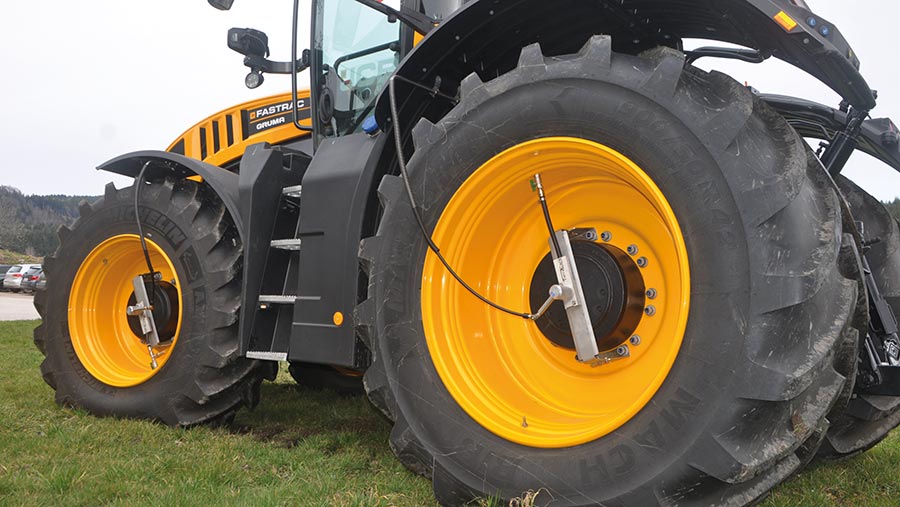
An over-the-wheel retrofit from TerraCare © TerraCare
Several retrofit systems with over-the-tyre air feed lines cater for tractors without an integral CTIS option, as well as other self-propelled equipment such as forage harvesters, sprayers and solids spreaders.
These can also provide simultaneous tyre pressure adjustment on tractors operating trailed equipment such as trailers, slurry tankers, manure spreaders and sprayers.
That has become a more useful facility now that VF technology, in terms of carcass and sidewall strength and flexibility, has migrated to flotation tyres such as BKT’s V-Flexa, Michelin’s TrailXBib and Yokohama’s Alliance Agriflex+ 389.
HM Trailers
HM Trailers has supplied several flatbed units for vegetable harvesting operations equipped with its own CTIS package using the tractor’s air brake compressor, a distribution manifold, trailer-mounted storage tanks and specialist rim valves.
Axles are reworked to channel air to the hub and then to the rims via short flexible hoses and dump valves for rapid venting.
The system “mops up” spare compressed air capacity during the typical 15-minute harvest loading cycle, ready to rapidly re-inflate the tyres, typically from 1.24 to 2.5 bar (18 to 37psi) in 10-12 seconds, and then up to 4.1 bar (60psi) over the next minute or two for the journey back to the store.
An embedded computer and control box monitors the outfit’s speed alongside the tyre pressures and will issue a warning if the speed limit for the low-pressure settings is exceeded before automatically inflating if necessary.
A typical trailer installation costs about £4,800.
AgriBrink
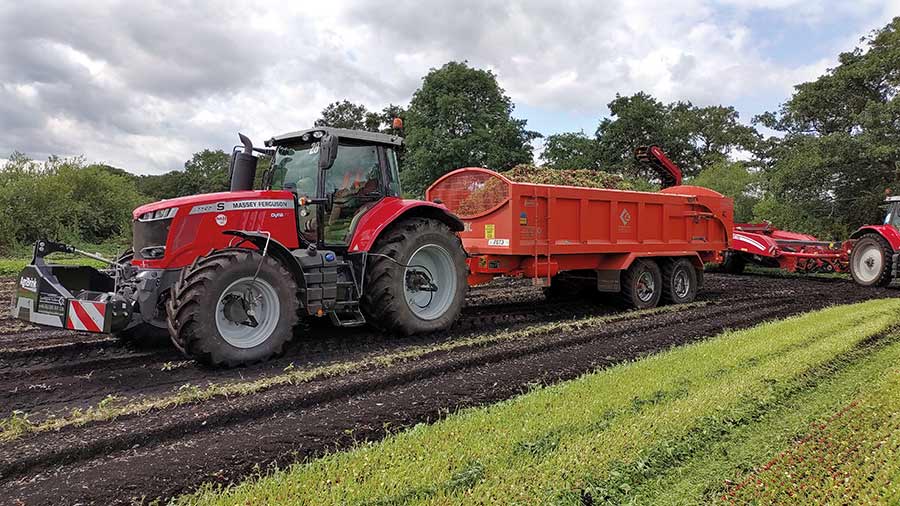
The AgriBrink system fitted to a tractor and trailer © Larrington Trailers
AgriBrink is an air inflation/deflation system from Canada supplied by Larrington Trailers. It features a front-mounted tractor bumper unit housing a large-capacity hydraulically driven compressor and two compressed air storage tanks.
A distribution manifold, regulated by an in-cab control unit programmed with the required inflation pressures, sends air to the tractor’s front tyres, rear tyres and trailer tyres for simultaneous adjustment.
A fourth channel is available for situations where the trailed equipment – such as a potato harvester – has tyres of different sizes, requiring different pressures.
Each channel can have three different pressures programmed – road, field unladen and field loaded, for example – selected by a toggle switch on the side of the controller.
The combination of storage tanks and large rim valves is said to enable inflating a complete set of tractor and trailer tyres from field to road pressures in about 90 seconds.
It is priced at £16,950 for the tractor system, plus £1,250 per wheel to extend it to trailed equipment.
TerraCare
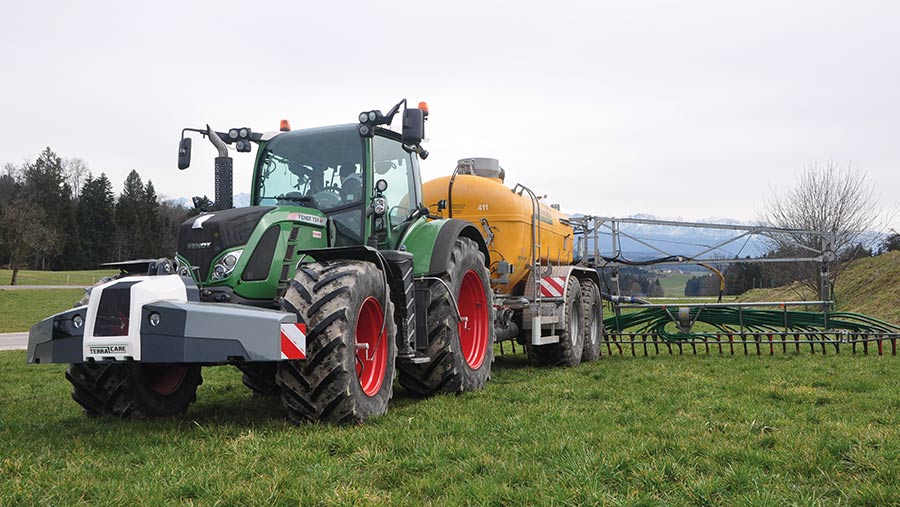
TerraCare’s front-mounted system © TerraCare
The TerraCare system from Austria also uses a dedicated compressor and air storage to achieve rapid inflation, either of tractor tyres alone or on a tractor and trailed equipment combination.
Various hardware packages are available, including trailer/tanker/spreader mounting, installation on the side or rear deck of a tractor, and front linkage-mounted modules, including the Air Power front bumper solution with lights and additional ballast weight options.
A choice of fan-cooled piston or screw compressors with capacities from 720 to 2,500 litres/min is complemented by compressed air storage of 80 to 260 litres.
Features and operation are broadly the same as other twin-line systems, but automatic pressure variation based on speed is a feature, together with the new GeoCare option that enables automatic pressure reduction triggered by a GPS location – when entering the field, for example.
TerraCare can supply systems direct to farm or dealer but has no UK sales or installation agent at present.
Michelin
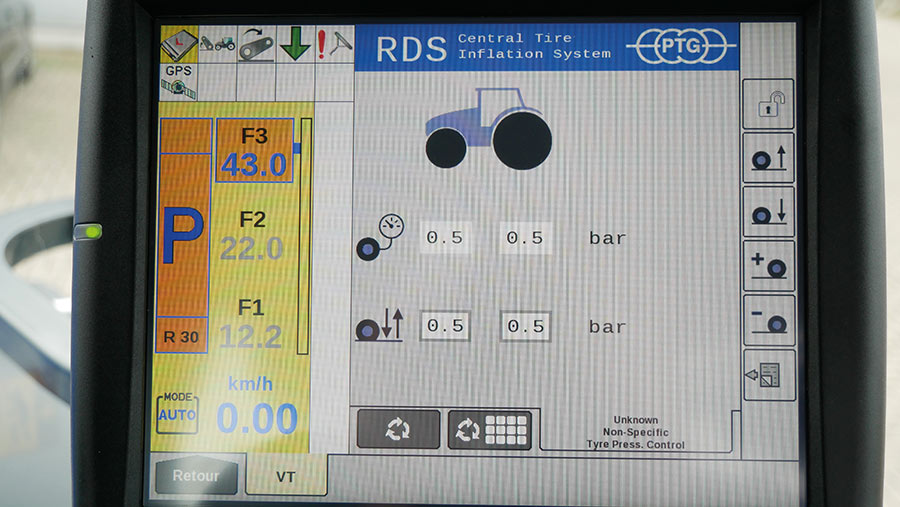
Michelin’s TractAir interface © Michelin
Having acquired the German CTIS manufacturer PTG in 2017, Michelin says it conducted numerous trials to refine the system and gather more data on its potential before rolling out the Zen@Terra CTIS and Ultraflex tyre technology package for high-horsepower tractors.
TractAir, which has a long association with PTG, is Michelin’s approved supplier and installer of the inflation management system, and continues to supply both single- and dual-line systems for most tractors, at prices typically starting at £6,000 to £8,000.
Dual-line systems use a pneumatic control line to open and close purpose-made wheel valves that allow air to be pumped in and let out faster than the standard valves (which remain in place).
Seals and air lines are pressurised only when increasing the tyre inflation pressure, so there is no loss of tyre pressure should the lines become damaged; which is a rare event in any case, says TractAir.
For ease of control, the Michelin/PTG CTIS system is operated through an Isobus terminal (a separate controller is also available) with tailor-made pressure settings as recommended by Michelin specialists programmed by the operator to suit axle loads, speeds, operation and terrain.
Pressures can be set for empty, half or full axle loads to optimise flotation and traction, or to provide extra stability when working across slopes.
A “boost” function deflates the tyres to an extreme low pressure for three minutes when extra grip is needed.
The CTIS system is connected to the tractor’s air trailer braking installation – another of TractAir’s specialities – with a priority valve ensuring a constant 6.5bar is available for the brakes.
Air lines are routed along bar axles with a rotary union fitted to the trumpet housing, while quick-release over-the-tyre pipework and rotary unions are fitted for flange rims.
TractAir reckons a typical installation will deflate a pair of 710/70 R42 from 1.4 bar (20psi) to 0.8 bar (12psi) in 90 seconds and do the reverse in about six minutes using the standard air brake compressor.

